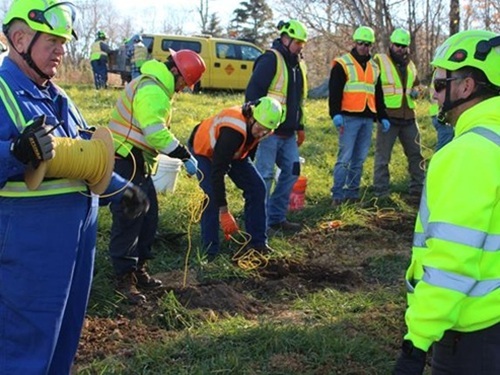The Arizona Department of Transportation recently added a new inspection tool to its year-round maintenance program for 50 pump stations that remove storm runoff from many sections of Phoenix-area freeways: aerial drones.
[Above photo by Arizona DOT]
The agency said its technicians now use a drone to monitor for cracks, leaks, worn parts or other problems within pump stations. The Arizona DOT added in a statement that the drone lets its crews examine areas that are difficult for them to access, including upper sections of pipes that lift stormwater from a pump station’s storage well.
First tested in February, the agency said the drone should allow its technicians to more than double the number of maintenance inspections they conduct annually.
The Arizona DOT added that pump stations typically operate with three or four engines and large pumps that they power. Crews conduct regularly scheduled inspections of the engines, including oil and fluid checks. They also conduct test runs of the pumps, which can be done even if there is no water in a station’s system.
Most pumps can lift more than 12,000 gallons per minute. However, strong summer storms that drop two or more inches of rain in an hour can challenge any drainage system. That’s why the agency said its technicians monitor pump station operations and are prepared to respond to maintenance needs.
State departments of transportation across the country are using drones in a variety of applications.
For example, a Washington State Department of Transportation Tacoma-area maintenance crew is currently testing drone technology that can remove graffiti from hard-to-reach places; applying paint from aerial positions to cover graffiti on bridge abutments and other types of transportation-related infrastructure.
Meanwhile, this spring, the Minnesota Department of Transportation used drones for its “aerial mapping operations” in the northwestern part of the state; using the aerial devices to help create a record of existing infrastructure and landscapes along rights-of-way managed by the agency for transportation planning and highway design.
In February, several state agencies in Alaska – including the Alaska Department of Transportation & Public Facilities – field tested a drone-based avalanche mitigation technology; a system that uses Uncrewed Aerial System or UAS craft to place and then remotely trigger explosives to create controlled avalanches in order to protect transportation infrastructure.
In December 2023, the Federal Aviation Administration issued a wide-ranging drone waiver to the aeronautics division of the Massachusetts Department of Transportation that allows the agency to fly drones over the state’s entire railroad network outside the remote drone operators’ fields of vision.
And in August 2023, the Georgia Department of Transportation began participating in a “drone as a first responder” or DFR program along a stretch of I-85.
 States
States
NCDOT Staff Participate in ‘Explosive’ Technical Training
December 19, 2025 States
States

